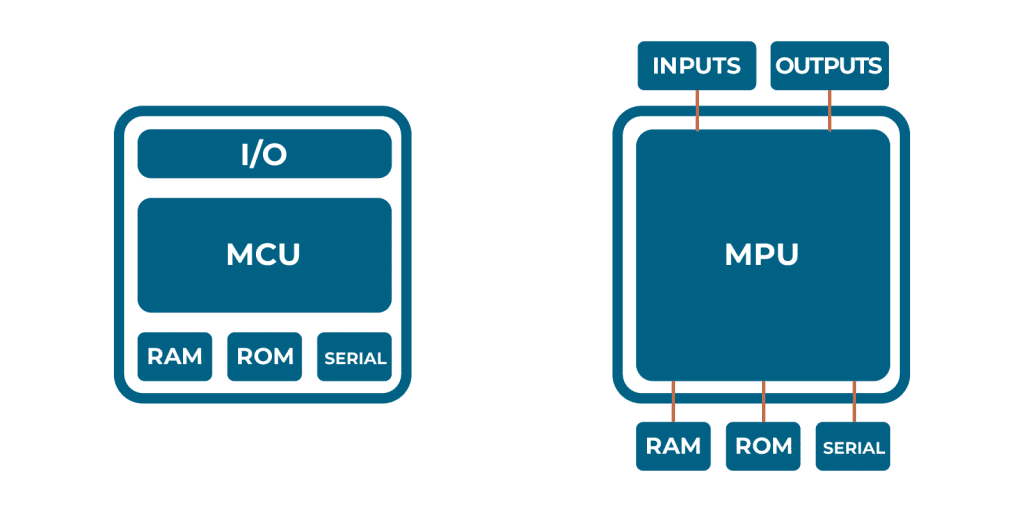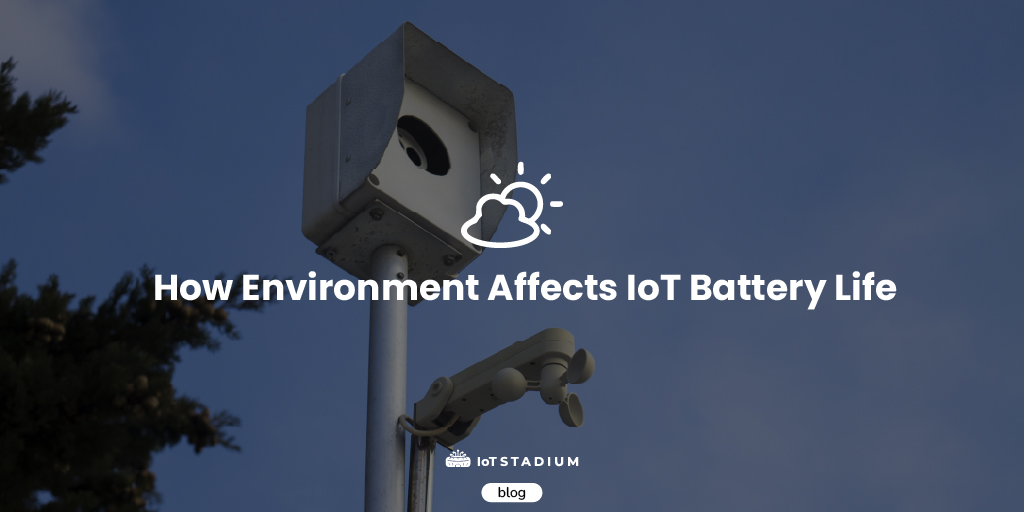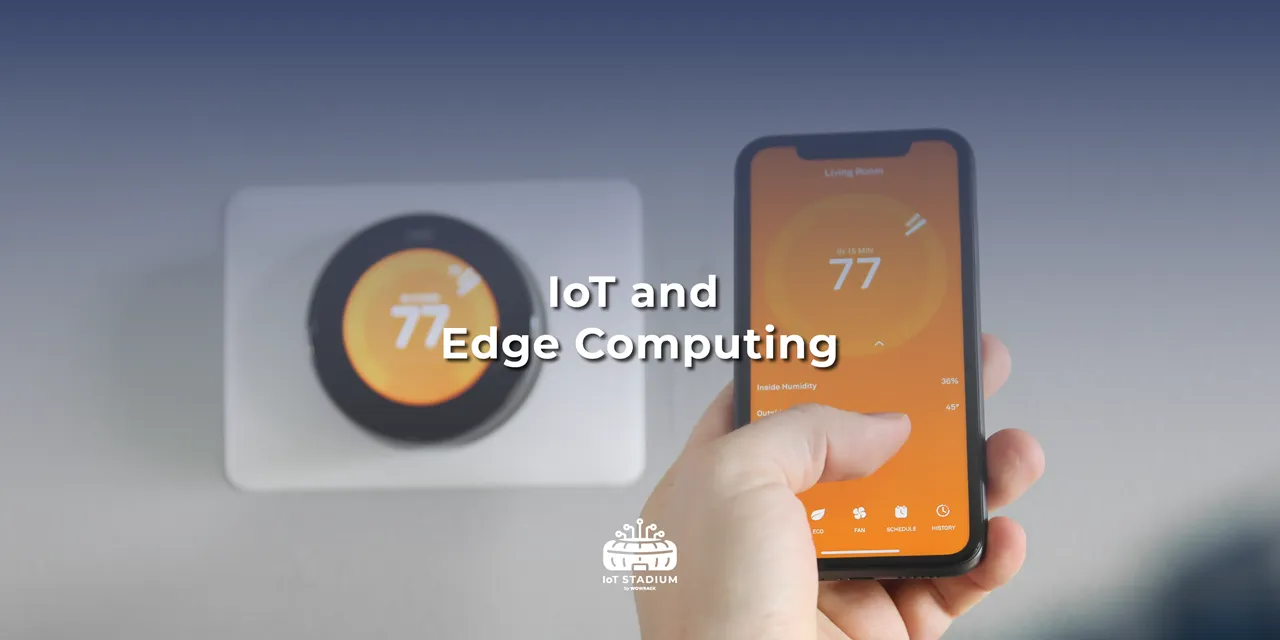There are a lot of microcontrollers for IoT you could use in making your own project. Imagine the microcontroller as a busy metropolis with a wide variety of architectural marvels. There are specialized buildings in this thriving metropolis, and each one is home to a multitude of distinct residents. Microcontrollers are similar to these marvels of architecture in the world of technology, offering a wide range of features to the extensive Internet of Things ecosystem. Similar to how distinguished city regions accommodate the diverse needs and preferences of their inhabitants, microcontrollers function as the unique building blocks of Internet of Things devices, providing customized solutions for particular uses.
Before we go deeper, let’s take a look at the different between microcontroller and microprocessor
Difference between Microcontroller (MCU) and Microprocessor (MPU)
Microprocessors and microcontrollers are not the same. Because microprocessors only have a CPU, they need additional components in order to function. However, MCUs are equipped with components like RAM, ROM, and such, which enable them to operate independently on (simple) tasks.
In the end, microcontrollers and microprocessors have very different uses, despite having similar names and looks. Although microprocessors are more potent, in order for them to work, larger systems must use them as individual parts. In contrast, microcontrollers have limited capabilities and power but can still handle basic tasks on their own. For example, your smartphone needs a microprocessor to manage all the different and hard jobs it does. In contrast, a smart plug uses a microcontroller, because it only needs to carry out basic functions.

Type of Microcontroller
Microcontrollers can be grouped based on their memory, architecture, and bits. These three factors determine the performance and capabilities of a microcontroller. The memory capacity determines the amount of data that can be stored and processed, while the architecture defines the organization and structure of the microcontroller's internal components. Additionally, the number of bits determines the size of data that can be processed in a single instruction, affecting the speed and efficiency of operations.
Bits
1. 8-bits microcontroller
These microcontrollers have an 8-bit data bus width, meaning they can process 8 bits of data in parallel. They are typically used in applications where cost, power consumption, and simplicity are critical factors. 8-bits microcontrollers are suitable for basic tasks and are widely used in various consumer electronics and low-end applications.
2. 16-bit microcontroller
Microcontrollers with a 16-bit data bus width can handle more data in parallel compared to 8-bit microcontrollers. This increased data processing capability allows them to perform more complex tasks. They are commonly used in applications that require moderate processing power and efficiency, such as industrial control systems and automotive electronics.
3. 32-bit microcontroller
32-bit microcontrollers have a wider data bus, allowing them to process even larger chunks of data simultaneously. They offer higher computational power, making them suitable for applications demanding advanced processing capabilities, multitasking, and high-performance computations. 32-bit microcontrollers are commonly used in medical devices, consumer electronics, and high-end industrial applications.
4. 64-bit microcontroller
64-bit microcontroller featuring a wide 64-bit data bus for high-performance processing. These microcontrollers excel in tasks demanding extensive computational power, large memory addressing, and efficient multitasking. Ideal for applications involving intricate calculations, massive datasets, graphics, multimedia, and server environments, they provide the processing muscle for cutting-edge embedded systems, ensuring seamless performance in advanced computing tasks.
Memory
1. Embedded Memory Microcontroller
With embedded memory, every memory block and module is contained in a single unit. This functional block has interrupts, timers, counters, program and data memory, and more. While memory blocks in microcontrollers cannot be expanded, ROM allows for memory expansion.
2. External Memory Microcontroller
This type of microcontroller requires an external connection in order to operate because it lacks one of the necessary memory blocks on the chip. The device's overall dimensions increase when external modules are used.
Architecture
1. Harvard
This particular kind of microcontroller can execute all instructions in a single machine cycle. It has two independent bus lines and independent memory for data, program memory, program code (instructions), and data memory, in that order. Because of its intricate design, it is more expensive.
2. Von Neumann
The program and data storage are stored in a single memory. It is a commonly used architecture in a wide range of desktop and laptop computers. An instruction took two machine cycles to finish. Given that it only needs one bus and has a straightforward design, it is far less expensive than Harvard architecture.
3. CISC (Complex Instruction Set Computer)
The CPU in this type of microcontroller is made to carry out a single, complicated command. It can use a single instruction to carry out several different operations. Its benefit is that its program is small in scope. However, it requires multiple machine cycles to execute due to the extensive size of its instruction set and numerous addressing modes, which makes it take a long time to complete.
4. RISC (Reduces Instruction Set Computer)
The CPU in this type of microcontroller is made to carry out short, straightforward commands. A single instruction can be reduced to execute complex instructions because it only requires one machine to execute.
Why use Microcontroller for IoT
We found four major reasons on why using microcontroller is a good way
1. Low Power Consumption:
MCUs are energy-efficient, making them ideal for battery-powered IoT devices, ensuring longer operational lifespans.
2. Cost-Effectiveness:
MCUs are affordable and cost-effective, enabling the mass production of IoT devices without significantly inflating manufacturing costs.
3. Real-time Processing:
MCUs offer real-time processing capabilities, ensuring immediate responses to sensor inputs and timely execution of IoT tasks, crucial for IoT applications requiring rapid data processing.
4. Compact Size and Customizability:
MCUs are compact and customizable, allowing seamless integration into small form factors. Their flexibility enables developers to tailor devices for specific IoT applications, meeting precise requirements without unnecessary complexity.
How to Choose the Right Microcontroller for You
Here are five essential tips for choosing the right microcontroller for your IoT projects:
1. Define Clear Requirements:
Clearly outline your project's requirements, including processing power, memory, communication interfaces, and power consumption. Know what your IoT device needs to do.
2. Consider Power Efficiency:
If your device will be battery-powered, prioritize microcontrollers with low power consumption and efficient sleep modes to prolong battery life.
3. Evaluate Communication Needs:
Choose an MCU with communication interfaces (Wi-Fi, Bluetooth, LoRa, etc.) that align with your project's connectivity requirements. Ensure compatibility with your desired communication protocols.
4. Check Development Ecosystem:
Assess the availability of a robust development environment, including software libraries and community support. A strong ecosystem simplifies the development process.
5. Factor in Security:
Prioritize MCUs with built-in security features like encryption and secure boot mechanisms. Ensure the MCU supports secure firmware updates, essential for IoT device security.
By focusing on these key aspects, you can make a well-informed decision when choosing a microcontroller for your IoT project.
Conclusion
In conclusion, it's crucial to recognize the distinction between microcontrollers and microprocessors, particularly in terms of their functions and internal components. Microcontrollers can be categorized based on three key aspects: bits, memory, and architecture. Understanding these differences is essential for making informed decisions when working with microcontrollers.
When selecting a microcontroller for your IoT project, it's crucial to follow these five essential tips: define your project requirements, prioritize power efficiency, establish the necessary communication protocols, assess the development ecosystem, and prioritize security considerations.
Visit our blog to get more information about technology. On the other hand, you can visit our knowledge base page for tutorials on how to use the features in IoT Stadium.




